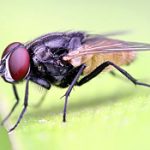The housefly (also house fly, house-fly or common housefly), Musca domestica, is the most common of all flies found in homes, and indeed one of the most widely distributed insects, found all over the world; it is often considered a pest that can carry serious diseases.
Even though the order of flies (Diptera) is much older, true houseflies are believed to have evolved in the beginning of the Cenozoic era, some 65 million years ago.[6] House flies feed on liquid or semi-liquid substances beside solid material which has been softened by saliva or vomit. Because of their high intake of food, they deposit feces constantly, one of the factors that makes the insect a dangerous carrier of pathogens. Although they are domestic flies, usually confined to the human habitations, they can fly for several miles from the breeding place. They are active only in daytime and rest at night e.g. at the corners of rooms, ceiling hangings, etc.

